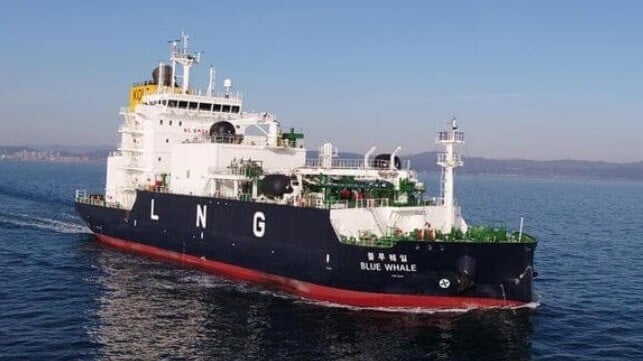Samsung Heavy Celebrates Maiden Voyage of Designed-in-Korea LNG Tank

South Korea's shipbuilding industry is taking another swing at a domestically-designed LNG containment tank system, hoping to circumvent the steep licensing fees charged by French engineering firm GTT. The first LNG carrier to sail with the newly redesigned Korean tank system has completed its maiden voyage, and shipyard Samsung Heavy Industries hailed it as a major milestone towards commercialization.
LNG containment tanks are hard to design and execute properly, and Korean yards have made a specialty out of their ability to build them. But the shipyards do not own the intellectual property behind the most accepted and efficient membrane tank technology, GTT's stainless steel liner and insulation layer system. There are few alternatives: older Moss-type spherical tanks are less space-efficient and are not used in modern construction, and homegrown alternative designs are tough to master. The tanks have to withstand cryogenic temperatures of -260 degrees Fahrenheit, and they cannot leak.
National LNG shipbuilding programs have a mixed history. An early push in the United States resulted in the delivery of 16 new hulls in the late 1970s, but three - Methane Delta, Epsilon and Zeta, built at Avondale - ended up sidelined because of tank problems. One was scrapped, and the other two were converted into bulkers.
South Korea's first attempt at a membrane tank system, the KC-1, also ended poorly. In 2018, Samsung Heavy constructed two full-size LNG carriers with a new tank designed by Korea Gas, and delivered them to shipowner SK Shipping. The vessels quickly developed "cold spots" - insulation flaws - that could not be resolved despite repeated attempts at repair. The two ships had to be removed from service, and SK Shipping eventually won hundreds of millions of dollars in arbitration claims against Samsung and Korea Gas.
Undeterred, Samsung Heavy Industries forged ahead with a new design, the KC-2C. It has a strong incentive for perseverance: for each LNG carrier built in Korea, GTT charges about five percent of the ship's price, adding up to billions of dollars in royalty payments that would otherwise stay in the shipyard's coffers. Samsung has developed a technological edge in the race: it is reportedly using high-spec welding robots to assemble the interior tank membrane panels, removing the variable of human skill level.
This time, SHI started small with a trial-scale tank on an LNG bunkering barge, the Green Nuri. It then built and delivered the Blue Whale, a small LNG bunkering ship with a tank volume of 7,500 cubic meters - about four percent of the size of a standard seagoing LNG carrier. This week, Samsung Heavy announced that shipowner Korea Line has completed the maiden voyage of another 7,500 cubic meter vessel, transporting a cargo from Tongyeong to Jeju, a short coastwise transit of about 120 nautical miles. The long-term objective is to scale the technology up to construct a full-size 174,000 cubic meter vessel and compete head-to-head with GTT-equipped hulls on the global market.
